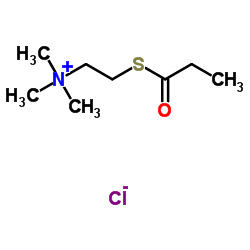propionylthiocholine iodide

propionylthiocholine iodide structure
|
Common Name | propionylthiocholine iodide | ||
|---|---|---|---|---|
| CAS Number | 1866-73-5 | Molecular Weight | 211.753 | |
| Density | 1.4391 (estimate) | Boiling Point | N/A | |
| Molecular Formula | C8H18INOS | Melting Point | 200-202ºC(lit.) | |
| MSDS | Chinese USA | Flash Point | N/A | |
| Symbol |


GHS05, GHS07 |
Signal Word | Danger | |
|
Evaluation of mechanisms of azinphos-methyl resistance in the codling moth Cydia pomonella (L.).
Arch. Insect Biochem. Physiol. 57(2) , 92-100, (2004) Resistance of the codling moth Cydia pomonella (L.) to azinphos-methyl is not based on enhanced detoxifying enzymes like oxidation mediated by mixed function oxidases or by glutathione S-transferases. Synergism by S,S,S-tributylphosphoro-trithioate was eviden... |
|
|
Differentiation of esterases reacting with organophosphorus compounds.
Chem. Biol. Interact. 87(1-3) , 77-83, (1993) The hydrolysis of paraoxon (POX), phenylacetate (PA) and beta-naphthylacetate (BNA) was studied in human serum. Based upon correlations between enzyme activities, upon reversible inhibition by EDTA and upon progressive inhibition by iso-OMPA, tabun, eserine a... |
|
|
Assay using succinyldithiocholine as substrate: the method of choice for the measurement of cholinesterase catalytic activity in serum to diagnose succinyldicholine sensitivity.
Clin. Chem. Lab Med. 41(3) , 317-22, (2003) No comparative information is available concerning the ability of various cholinesterase (ChE) methods to identify succinyldicholine-sensitive patients, purely on the basis of the enzyme activity recorded in serum. Here, we evaluated six different methods for... |
|
|
Characterization of a pseudocholinesterase purified from surgeonfish tissues confirms the atypical nature of this enzyme.
J. Exp. Zool. 247(3) , 198-208, (1988) The sialated, presumed-globular form of an atypical pseudocholinesterase (pseudo-ChE) previously described from surgeonfish tissues (Leibel: Comparative Biochemistry and Physiology 1988) has been purified to apparent homogeneity using a combination of salt fr... |
|
|
Purification and characterization of an acetylcholinesterase from the infective juveniles of Heterorhabditis bacteriophora.
Comp. Biochem. Physiol. C. Toxicol. Pharmacol. 146(3) , 314-24, (2007) Acetylcholinesterases (AChEs) have been estimated in the infective juveniles (IJs) of eight different strains of heterorhabditid nematodes. The enzyme content ranged from 45.6 to 421.3 units/10(5) IJs with specific activity 34.0 to 82.6 units/mg protein. The ... |
|
|
Characterization of trimeric acetylcholinesterase from a legume plant, Macroptilium atropurpureum Urb.
Planta 227(4) , 809-22, (2008) We recently identified plant acetylcholinesterases (E.C.3.1.1.7; AChEs) homologous to the AChE purified from a monocotyledon, maize, that are distinct from the animal AChE family. In this study, we purified, cloned and characterized an AChE from a dicotyledon... |
|
|
Spontaneous recovery of cholinesterases after organophosphate intoxication: effect of environmental temperature.
Bull. Environ. Contam. Toxicol. 40(3) , 358-64, (1988)
|
|
|
APseudomonas aeruginosaPAO1 acetylcholinesterase is encoded by thePA4921gene and belongs to the SGNH hydrolase family
Microbiol. Res. 167(6) , 317-25, (2012) Through the use of molecular and biochemical experiments and bioinformatic tools, this work demonstrates that the PA4921 gene of the Pseudomonas aeruginosa PAO1 genome is a gene responsible for cholinesterase (ChoE) activity. Similar to the acetylcholinestera... |
|
|
An explanation for the different inhibitory characteristics of human serum butyrylcholinesterase phenotypes deriving from inhibition of atypical heterozygotes.
Chem. Biol. Interact. 119-120 , 159-64, (1999) The time course of inhibition of butyrylcholinesterase (EC 3.1.1.8) by the dimethylcarbamate Ro 02-0683 in sera taken from patients heterozygous for the usual (U), atypical (A), K or J variants was followed using propionylthiocholine as substrate. Data obtain... |
|
|
Bivalve esterases as biomarker: identification and characterization in European cockles (Cerastoderma edule).
Bull. Environ. Contam. Toxicol. 88(5) , 707-11, (2012) This study characterized esterase activity in Cerastoderma edule tissues using different substrates and specific inhibitors and identified the tissue distribution of esterases in this species. Synthetic thiocholines and thioacetate esters and specific inhibit... |